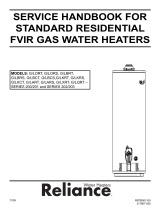
6
MAINTENANCE
WATER HEATER TEMPERATURE-PRESSURE
RELIEF VALVE
DANGER
• Burn hazard.
• Hot water discharge.
• Keep clear of Temperature-
Pressure Relief Valve
discharge outlet.
The Temperature-Pressure Relief Valve on the water heater must
be manually operated at least once a year.
When checking the Temperature-Pressure Relief Valve operation,
make sure that (1) no one is in front of or around the outlet of the
Temperature-Pressure Relief Valve discharge line, and (2) that
the water discharge will not cause any property damage, as the
water may be extremely hot. Use care when operating valve as
the valve may be hot.
To check the relief valve, lift the lever at the end of the valve
several times, see Figure 2. The valve should seat properly and
operate freely.
DISCHARGE PIPE
TEMPERATURE-PRESSURE
RELIEF VALVE
FIGURE 2.
If after manually operating the valve, it fails to completely reset
and continues to release water, immediately close the cold water
inlet to the water heater and drain the water heater. Follow draining
instructions in the Instruction Manual that came with the water heater.
Replace the Temperature-Pressure Relief Valve with a properly
rated/sized new one. See the Temperature-Pressure Relief Valve
instructions in the Instruction Manual that came with the water
heater for information on replacement.
WEEPING TEMPERATURE-PRESSURE RELIEF VALVE
If the Temperature-Pressure Relief Valve on the water heater
weeps or discharges periodically, this may be due to one or more
of the following conditions:
1. The Temperature-Pressure Relief Valve may be worn or
clogged with lime/calcium accumulation and need to be
replaced. Refer to the Instruction Manual that came with the
water heater for information on replacement.
2. The inlet water pressure may be above the recommended
60 PSI. Follow the instructions in the “Adjusting Water Pressure”
section of this manual.
3. The expansion tank’s air charge pressure may not be set to
match the incoming water pressure. Follow the instructions
in the “Checking Expansion Tank Air Charge” section of
this manual.
If all the above have been checked, adjusted and/or replaced, turn
the water heater “OFF” and call the local utility.
Explosion Hazard
Temperature-Pressure Relief Valve
must comply with ANSI Z21.22-
CSA 4.4 and ASME code.
Properly sized Temperature-Pressure
Relief Valve must be installed in
opening provided.
Can result in overheating and
excessive tank pressure.
Can cause serious injury or death.
Note: Do not plug the Temperature-Pressure Relief Valve opening.
This can cause property damage, serious injury or death.
TANK MAINTENANCE
Unless otherwise stated, at least once every 6 months, the
expansion tank must be checked to verify that the pre-charge
is within the value indicated on the label (factory pre-charge or
customer set pre-charge). Always check the pre-charge when the
tank is isolated and empty of water.
• Inspect the tank visually for signs of damage / corrosion at least
once every 6 months
• To lengthen the life of the expansion tanks external protection,
periodically clean the external portions of the tank using warm
soap and water
• To ensure the proper functioning of the system, the expansion
tank must be replaced in the event of excessive deterioration
line you can either call your local water department or you can get
a close approximation from your Expansion Tank. If you follow the
above procedure with your tank installed and read the air pressure
from your tank you will have an approximate system pressure. (In
this case read the pressure with the tank full of water). If the air
pressure reads 50 PSI you need to shut-off your main water line,
open a valve let the water out of the tank, and ll the tank with 50
PSI of air pressure.
5. Open the cold water supply valve.
6. Now the water heater can be put back into operation. Follow
instructions found on the water heater and in the manual.
7. Failure to properly size the expansion tank and to properly adjust
the pre-charge will shorten the life expectancy of the product, can
void the product warranty, and can lead to premature failure.








